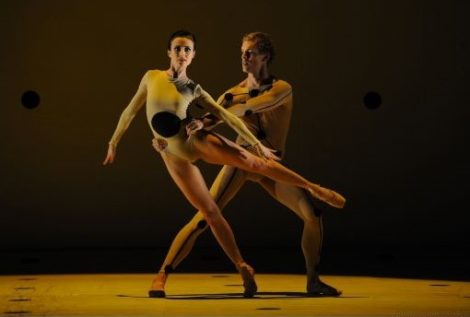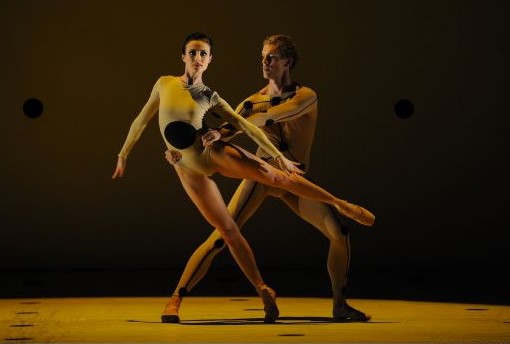It is an ongoing fascination being able to watch streaming sessions of works I have seen live (often more than once). The Australian Ballet’s triple bill of Graeme Murphy’s The Narrative of Nothing, Stephen Page’s Warumuk—in the dark night, and Wayne McGregor’s Dyad 1929 has been no exception. From this program, Dyad 1929 stood out for the new insights into the work that it gave me.
Dyad 1929 was first seen in Australia in 2009 as part of a program called Concord. It was, in fact, made on the Australian Ballet as part of its Ballets Russes project. We saw it again in 2013 also as part of a mixed bill, this time called Vanguard. Then this year it had just a few performances in March in Melbourne, as part of a program called Volt, before the COVID-19 pandemic closed everything down. The Volt season was cancelled.
What I especially enjoyed when watching Dyad 1929 on screen was a duet danced by Amber Scott and Adam Bull. As they came onstage for this duet there was an unexpected mood change, choreographically, visually and musically (Dyad 1929 is danced to Steve Reich’s Double Sextet). From the fast-paced first sections with their rush of extreme movement under Lucy Carter’s bright white lighting, the setting darkened as a horizontal bar of fluorescent yellow lights began to descend from the flies. A yellow circle of light appeared on the stage floor and the music, unexpectedly, became moody and slightly mysterious.
Choreographically, movements seemed less sharp. They were still extreme and filled with eccentricities—Scott executed a series of cabriole-style beats while being held by Bull in a kind of fish dive pose—but there was often a more gentle feel to much of the dancing. Having said that, occasionally a beautiful slow unfolding of the leg was followed quickly by a sudden movement, although this kind of juxtaposition is not unusual for McGregor. Then there was the moment—gone in a flash—when Scott made a small circle with thumb and index finger and held it up to her eye like a monocle. It echoed the large black circle on her costume and also the rows of black dots we see on the back- and floorcloth.
The duet was eventually interrupted by the appearance of other dancers and the work continued. But I loved seeing Scott and Bull together and I loved having the luxury of noticing tiny aspects of the choreography that I missed on previous, live viewings.
Because the streaming of Dyad 1929 finishes on 28 May 2020, below is a video of Scott and Bull rehearsing the duet I enjoyed so much. While the rehearsal in the studio lacks something of the punch that the duet had in performance, it is nevertheless a record of the choreography. It was interesting too to see Antoine Vereecken, who staged the work in 2013, giving comments at the end of the rehearsal.
Looking back at Wayne McGregor’s program note from both 2009 and 2013, I noticed he had dedicated Dyad 1929 to Merce Cunningham, who died in 2009 the year of the premiere of Dyad 1929. McGregor wrote of Cunningham that he was ‘a choreographer whose curiosity, sense of adventure and seamless collaboration knew no bounds.’ I can often see similar characteristics in McGregor’s works. Read more about my thoughts on his works at this tag.
Michelle Potter, 21 May 2020
Featured image: Amber Scott and Adam Bull in Dyad 1929. The Australian Ballet, 2013. Photo: © Branco Gaica

